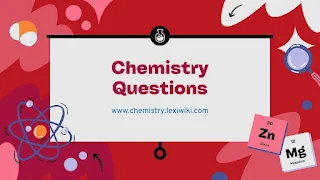Questions on Gay-Lussac’s Law
Gay-Lussac’s Law – Multiple Choice Questions
1. Gay-Lussac’s Law relates which two properties of a gas?
A) Volume and pressure
B) Pressure and temperature
C) Volume and temperature
D) Mass and temperature
E) Density and volume
2. According to Gay-Lussac’s Law, the pressure of a gas is:
A) Inversely proportional to temperature
B) Independent of temperature
C) Directly proportional to temperature
D) Equal to volume
E) Unaffected by pressure changes
3. Which condition must remain constant for Gay-Lussac’s Law to be valid?
A) Volume
B) Pressure
C) Temperature
D) Mass
E) Density
4. The correct mathematical expression of Gay-Lussac’s Law is:
A) P × V = constant
B) V/T = constant
C) P/T = constant
D) VT = constant
E) PV/T = constant
5. If the temperature of a gas increases while volume stays constant, its pressure will:
A) Decrease
B) Stay the same
C) Increase
D) Become zero
E) Become undefined
6. Which temperature scale must be used in Gay-Lussac’s Law calculations?
A) Celsius
B) Fahrenheit
C) Kelvin
D) Rankine
E) Centigrade
7. A gas at 300 K has a pressure of 2.0 atm. What is the pressure at 600 K if volume is constant?
A) 1.0 atm
B) 2.0 atm
C) 3.0 atm
D) 4.0 atm
E) 6.0 atm
8. If the temperature of a gas in Kelvin is halved and the volume is constant, the pressure:
A) Is halved
B) Is doubled
C) Remains constant
D) Is squared
E) Becomes infinite
9. Gay-Lussac’s Law best applies to which type of gas?
A) Noble gases
B) Ideal gases
C) Liquids at high temperature
D) Gases under compression
E) Real gases at low pressure
10. A graph of pressure vs. temperature in Kelvin for Gay-Lussac’s Law is:
A) A hyperbola
B) A vertical line
C) A straight line
D) A sine wave
E) A parabolic curve
11. If pressure increases while temperature stays constant, which law is being violated?
A) Boyle’s Law
B) Charles’s Law
C) Gay-Lussac’s Law
D) Newton’s Law
E) Avogadro’s Law
12. A rigid, sealed container is heated. What happens to the pressure inside according to Gay-Lussac’s Law?
A) It stays constant
B) It decreases
C) It increases
D) It fluctuates
E) It equals zero
13. Gay-Lussac’s Law assumes that the gas behaves:
A) As a solid
B) Non-linearly
C) Ideally
D) As a plasma
E) As a liquid
14. Why must Kelvin temperature be used in Gay-Lussac’s Law?
A) Celsius is more accurate
B) Kelvin is required for inverse proportionality
C) Kelvin avoids division by zero or negative temperatures
D) Pressure is only measured in Kelvin
E) Kelvin is a universal gas unit
15. What happens to gas pressure at constant volume if the temperature is reduced to 0 K?
A) It increases
B) It becomes infinite
C) It becomes zero
D) It fluctuates randomly
E) It equals the atmospheric pressure
16. A steel tank with fixed volume shows a pressure of 4 atm at 400 K. What is the pressure at 200 K?
A) 2 atm
B) 6 atm
C) 1 atm
D) 4 atm
E) 8 atm
17. Gay-Lussac’s Law is useful in understanding:
A) How a balloon expands
B) How a scuba tank behaves when heated
C) Why liquids boil
D) Why solids melt
E) How vacuums form
18. Which of the following real-world examples best demonstrates Gay-Lussac’s Law?
A) A balloon rising in the air
B) A tire exploding on a hot day
C) A gas cooling when released
D) A vacuum chamber being emptied
E) A gas condensing into a liquid
19. Which of the following is not an assumption of Gay-Lussac’s Law?
A) Gas does not react
B) Volume is constant
C) Gas behaves ideally
D) Temperature is in Kelvin
E) Pressure is zero
20. If pressure and temperature are both doubled, what remains constant in Gay-Lussac’s Law?
A) Pressure
B) Volume
C) Mass
D) P/T ratio
E) Density
Answers with Explanations
1. B – Gay-Lussac’s Law relates pressure and temperature.
2. C – At constant volume, pressure increases with temperature.
3. A – Volume must stay constant for this law to hold.
4. C – The correct form is P/T = constant.
5. C – More temperature = more pressure if volume is unchanged.
6. C – Kelvin is required to avoid negative temperatures.
7. D – Use P₁/T₁ = P₂/T₂ → 2/300 = P/600 → P = 4.0 atm.
8. A – Halving temperature halves the pressure (direct proportion).
9. B – Gay-Lussac’s Law is based on ideal gas behavior.
10. C – A straight line: pressure vs. temperature in Kelvin.
11. C – Pressure should change only with temperature, not by itself.
12. C – Rigid container → volume constant → pressure rises with heat.
13. C – The law assumes ideal gas behavior.
14. C – Kelvin ensures temperature is always positive and avoids 0 in the denominator.
15. C – Theoretically, pressure becomes zero at absolute zero (0 K).
16. A – P₁/T₁ = P₂/T₂ → 4/400 = P/200 → P = 2 atm.
17. B – The pressure in the tank increases with heat even though volume doesn’t change.
18. B – Heat increases gas pressure, which can lead to explosion.
19. E – Zero pressure is not an assumption of Gay-Lussac’s Law.
20. D – If both pressure and temperature double, P/T remains constant.
Dive into the groundbreaking science of neurotransmitters—your brain’s invisible architects—in Chemical Harmony: How Neurotransmitters Shape Our Lives (2025). This meticulously researched book reveals how serotonin, dopamine, GABA, and other brain chemicals silently orchestrate every aspect of your existence, from decision-making and relationships to mental health and emotional resilience.Click here to buy
Share Online!

